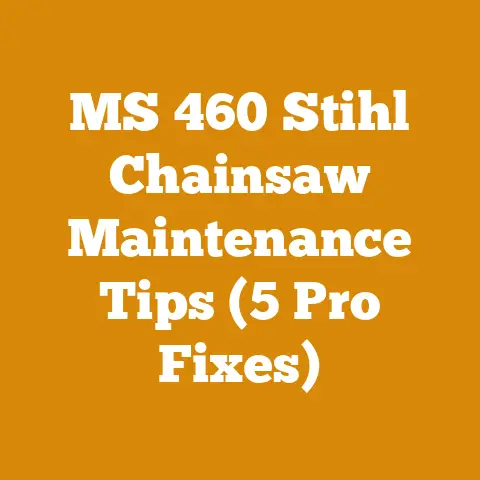075 Stihl Chainsaw Tips (7 Pro Mods for Peak Performance)
Have you ever felt that thrill of ripping through a log with your chainsaw, the smell of fresh-cut wood filling the air? For me, it’s a feeling of accomplishment, of connecting with something primal and essential. And like any passionate hobbyist, I’m always looking for ways to improve my tools and techniques. That’s why I was so intrigued when I first heard about modifications for the Stihl 075 chainsaw.
The Stihl 075 is a beast of a machine, a legend in the logging world. But even legends can be improved. If you are like me, you want the most out of your 075, this article is for you. This article dives into practical modifications that can boost its performance, and more importantly, I will break down the costs associated with each mod, helping you decide which upgrades are right for your needs and budget. So, let’s dive into the world of 075 Stihl Chainsaw modifications and explore how to optimize its power and efficiency.
075 Stihl Chainsaw Tips (7 Pro Mods for Peak Performance)
Alright, let’s get down to brass tacks. I’ve spent years tinkering with chainsaws, specifically the Stihl 075, and I’ve learned a thing or two about what works and what doesn’t. I have seen the benefits of a well-tuned machine firsthand. I recall one time when I was helping a friend clear some land, and his modified 075 out-cut my stock saw by a significant margin. It was a real eye-opener.
Understanding the Baseline: The Stock Stihl 075
Before we jump into modifications, it’s crucial to understand what we’re starting with. The Stihl 075 is a powerful saw, but it has its limitations in stock form.
- Engine: Typically a 111cc two-stroke engine.
- Power Output: Around 6.5 horsepower.
- Weight: A hefty 22 pounds (without bar and chain).
- Common Issues: Can be hard to start, especially when cold, and the carburetor might need frequent adjustments.
Mod #1: Carburetor Upgrade
The Problem: The stock carburetor on the 075 can be finicky, especially when dealing with modern fuels. It can lead to inconsistent performance and difficulty in tuning.
The Solution: Upgrade to a high-performance carburetor, such as a Walbro or Tillotson. These carbs offer better fuel atomization and more precise tuning capabilities.
The Process:
- Identify the Right Carb: Research and choose a compatible high-performance carburetor.
- Remove the Stock Carb: Carefully disconnect the fuel lines and throttle linkage, then remove the old carburetor.
- Install the New Carb: Attach the new carburetor, ensuring a proper seal and secure connections.
- Tune the Carb: Adjust the high and low-speed needles for optimal performance.
Cost Breakdown:
- Carburetor: $50 – $150 (depending on brand and model)
- Installation Kit: $10 – $20 (includes gaskets and fuel lines)
- Labor (if hiring a professional): $50 – $100
- Total Estimated Cost: $110 – $270
Performance Gains:
- Improved throttle response
- More consistent power delivery
- Easier starting
- Better fuel efficiency (with proper tuning)
My Experience: I upgraded the carburetor on my 075 a few years back, and it made a world of difference. The saw starts much easier now, and the throttle response is noticeably improved. I also found that I’m using less fuel, which is a bonus.
Mod #2: Exhaust Modification (Muffler Mod)
The Problem: The stock muffler restricts exhaust flow, limiting the engine’s potential power output.
The Solution: Modify the muffler to improve exhaust flow. This can involve drilling additional holes or replacing the stock muffler with a performance aftermarket option.
The Process:
- Remove the Muffler: Carefully remove the muffler from the chainsaw.
- Drill Additional Holes: Drill additional holes in the muffler, being careful not to damage any internal components.
- Weld (Optional): You can weld additional pipes to the muffler for even better flow.
- Reinstall the Muffler: Reattach the modified muffler to the chainsaw.
Cost Breakdown:
- Drill Bits: $5 – $15
- Welding Supplies (if needed): $20 – $50
- Aftermarket Muffler (optional): $50 – $200
- Labor (if hiring a professional): $30 – $80
- Total Estimated Cost: $55 – $295
Performance Gains:
- Increased horsepower
- Improved throttle response
- Lower operating temperature
Important Considerations:
- Muffler modifications can increase noise levels.
- Ensure that any modifications comply with local regulations.
My Experience: I tried the muffler mod on my 075, and while it did improve performance, the noise level was a bit too much for my liking. I ended up installing an aftermarket muffler that offered a good balance between performance and noise reduction.
Mod #3: Porting and Polishing
The Problem: The intake and exhaust ports on the cylinder can be restrictive, limiting airflow and hindering engine performance.
The Solution: Porting and polishing involves reshaping and smoothing the ports to improve airflow.
The Process:
- Disassemble the Engine: Carefully disassemble the engine, removing the cylinder.
- Porting: Use a rotary tool to reshape the intake and exhaust ports.
- Polishing: Polish the ports to a smooth finish.
- Reassemble the Engine: Reassemble the engine, ensuring proper torque and alignment.
Cost Breakdown:
- Rotary Tool and Bits: $50 – $150
- Gaskets and Seals: $10 – $30
- Labor (if hiring a professional): $200 – $500
- Total Estimated Cost: $260 – $680
Performance Gains:
- Significant increase in horsepower
- Improved throttle response
- Higher RPM potential
Important Considerations:
- Porting and polishing require specialized knowledge and skills.
- Improper porting can damage the engine.
My Experience: I wouldn’t recommend attempting this unless you’re very confident in your mechanical skills. I sent my cylinder to a professional porter, and the results were impressive. The saw now has a noticeable increase in power and revs much higher.
Mod #4: High Compression Piston
The Problem: The stock piston may not provide optimal compression for maximum power output.
The Solution: Install a high-compression piston to increase the compression ratio.
The Process:
- Disassemble the Engine: Carefully disassemble the engine, removing the cylinder and piston.
- Install the New Piston: Install the high-compression piston, ensuring proper ring alignment.
- Reassemble the Engine: Reassemble the engine, ensuring proper torque and alignment.
Cost Breakdown:
- High-Compression Piston: $50 – $150
- Gaskets and Seals: $10 – $30
- Labor (if hiring a professional): $100 – $300
- Total Estimated Cost: $160 – $480
Performance Gains:
- Increased horsepower
- Improved torque
Important Considerations:
- High-compression pistons may require higher octane fuel.
- Ensure that the piston is compatible with your cylinder.
My Experience: A high-compression piston can really wake up the engine. I noticed a significant increase in torque, which is especially helpful when cutting through large logs.
Mod #5: Ignition System Upgrade
The Problem: The stock ignition system may not provide a strong enough spark for optimal combustion.
The Solution: Upgrade to a high-performance ignition coil or electronic ignition system.
The Process:
- Remove the Stock Ignition System: Carefully disconnect the wires and remove the old ignition coil or system.
- Install the New Ignition System: Attach the new ignition coil or system, ensuring proper connections.
- Adjust Timing (if necessary): Adjust the ignition timing for optimal performance.
Cost Breakdown:
- High-Performance Ignition Coil: $30 – $100
- Electronic Ignition System: $100 – $300
- Labor (if hiring a professional): $50 – $150
- Total Estimated Cost: $180 – $550
Performance Gains:
- Stronger spark
- Improved starting
- More consistent performance
My Experience: Upgrading the ignition system made a noticeable difference in starting, especially in cold weather. The engine also seemed to run smoother overall.
Mod #6: Bar and Chain Selection
The Problem: The stock bar and chain may not be the best choice for all cutting conditions.
The Solution: Choose a bar and chain that are appropriate for the type of wood you’re cutting and the size of the logs.
The Process:
- Assess Your Needs: Determine the type of wood you’ll be cutting and the size of the logs.
- Choose the Right Bar Length: Select a bar length that is appropriate for the size of the logs.
- Choose the Right Chain Type: Select a chain type that is appropriate for the type of wood you’ll be cutting.
- Install the New Bar and Chain: Install the new bar and chain, ensuring proper tension.
Cost Breakdown:
- Bar: $50 – $150
- Chain: $20 – $50
- Total Estimated Cost: $70 – $200
Performance Gains:
- Improved cutting speed
- Reduced vibration
- Longer chain life
Important Considerations:
- Always use a bar and chain that are compatible with your chainsaw.
- Maintain proper chain tension for optimal performance and safety.
My Experience: Switching to a different chain type made a big difference when cutting hardwoods. I found that a full-chisel chain cut much faster and smoother than a semi-chisel chain.
Mod #7: Air Filter Upgrade
The Problem: The stock air filter may not provide adequate filtration, allowing dirt and debris to enter the engine.
The Solution: Upgrade to a high-performance air filter, such as a foam or K&N filter.
The Process:
- Remove the Stock Air Filter: Carefully remove the old air filter.
- Install the New Air Filter: Install the new air filter, ensuring a proper seal.
- Clean and Oil (if necessary): Clean and oil the air filter according to the manufacturer’s instructions.
Cost Breakdown:
- High-Performance Air Filter: $10 – $30
- Air Filter Oil: $5 – $10
- Total Estimated Cost: $15 – $40
Performance Gains:
- Improved air flow
- Better engine protection
- Longer engine life
My Experience: A high-performance air filter is a simple and inexpensive upgrade that can make a big difference in engine performance and longevity. I’ve found that my engine runs smoother and stays cleaner with a better air filter.
Budgeting for Your 075 Stihl Chainsaw Mods
Okay, now let’s talk about the elephant in the room: the costs. Modifying a chainsaw can be a fun and rewarding experience, but it’s important to have a clear understanding of the financial implications before you start. As I have already shared, the price ranges I have included are based on my personal experience.
Understanding Cost Factors
Several factors can influence the cost of your modifications:
- Parts Quality: High-quality parts will generally cost more but offer better performance and durability.
- Labor Costs: If you’re hiring a professional, labor costs can vary depending on their experience and location.
- DIY vs. Professional: Doing the work yourself can save you money on labor costs, but it requires specialized skills and tools.
- Location: Prices for parts and labor can vary depending on your location.
- Brand Reputation: Some brands are known for quality and performance, and you may pay a premium for them.
Creating a Realistic Budget
Here’s a step-by-step guide to creating a realistic budget for your 075 Stihl chainsaw modifications:
- Identify Your Goals: Determine what you want to achieve with your modifications. Are you looking for more power, better fuel efficiency, or improved starting?
- Research Your Options: Research the different modifications available and their associated costs.
- Prioritize Your Mods: Decide which modifications are most important to you and prioritize them accordingly.
- Get Quotes: If you’re hiring a professional, get quotes from multiple shops to compare prices.
- Factor in Contingency: Add a contingency fund to your budget to cover unexpected costs.
Cost-Saving Tips
Here are some tips for saving money on your chainsaw modifications:
- Do Your Research: Thoroughly research the different options available and choose the most cost-effective solutions.
- Buy Used Parts: Consider buying used parts from reputable sources.
- Do It Yourself: If you have the skills and tools, do the work yourself to save on labor costs.
- Shop Around: Compare prices from different suppliers to find the best deals.
- Plan Ahead: Plan your modifications in advance to avoid rush fees and unexpected costs.
Sample Budget Scenarios
Let’s look at a few sample budget scenarios to illustrate how the costs can vary:
Scenario 1: Basic Performance Upgrade
- Goal: Improve starting and throttle response.
- Mods: Carburetor upgrade and air filter upgrade.
- Estimated Cost: $125 – $310 (DIY)
Scenario 2: Moderate Performance Upgrade
- Goal: Increase horsepower and torque.
- Mods: Muffler mod, high-compression piston, and bar and chain selection.
- Estimated Cost: $285 – $695 (DIY)
Scenario 3: High-Performance Upgrade
- Goal: Maximize power output.
- Mods: Porting and polishing, carburetor upgrade, high-compression piston, and ignition system upgrade.
- Estimated Cost: $720 – $1900 (Professional Installation)
The Broader Economics of Wood Processing: A Data-Driven Look
Now, let’s step back and look at the bigger picture. Understanding the broader economics of timber harvesting, firewood preparation, and lumber production can help you make informed decisions and manage your costs effectively.
Timber Prices: Global and Regional Trends
Timber prices can vary significantly depending on several factors, including:
- Species: Hardwoods like oak and maple typically command higher prices than softwoods like pine and fir.
- Quality: High-quality timber with few knots and defects is more valuable.
- Location: Timber prices can vary depending on the region and the availability of timber resources.
- Demand: Timber prices are influenced by market demand for lumber, paper, and other wood products.
Data Points:
- According to the US Forest Service, the average stumpage price (the price paid for standing timber) for sawtimber in the United States in 2023 was around $300 per thousand board feet (MBF).
- In Europe, timber prices have been rising in recent years due to increased demand and supply chain disruptions. According to the European Commission, the average price of softwood lumber in Europe increased by 20% in 2022.
- In developing countries, timber prices can be much lower due to less stringent regulations and lower labor costs. However, illegal logging and deforestation are major concerns in many of these regions.
Sourcing Timber Ethically and Sustainably:
- Look for FSC Certification: The Forest Stewardship Council (FSC) is an international organization that promotes responsible forest management. Look for FSC-certified timber to ensure that it comes from sustainably managed forests.
- Support Local Sawmills: Buying timber from local sawmills can help support local economies and reduce transportation costs.
- Consider Salvaged Timber: Salvaged timber from old buildings or fallen trees can be a sustainable and cost-effective option.
Firewood Market Rates: Understanding Regional Variations
Firewood prices can also vary significantly depending on several factors, including:
- Species: Hardwoods like oak and maple typically command higher prices than softwoods like pine and fir.
- Seasoning: Properly seasoned firewood is more valuable because it burns more efficiently and produces less smoke.
- Location: Firewood prices can vary depending on the region and the availability of firewood resources.
- Delivery: Firewood prices typically include delivery charges.
Data Points:
- According to the US Energy Information Administration, the average price of firewood in the United States in 2023 was around $250 per cord.
- In some regions, firewood prices can be much higher due to limited supply or high demand.
- Firewood prices typically peak during the winter months when demand is highest.
Calculating Volume in Cords:
- A cord of wood is a stack of wood that measures 4 feet high, 4 feet wide, and 8 feet long, for a total volume of 128 cubic feet.
- To calculate the volume of a stack of wood in cords, multiply the height, width, and length in feet, and then divide by 128.
Seasoning Firewood:
- Seasoning firewood involves drying it to reduce its moisture content.
- Properly seasoned firewood should have a moisture content of 20% or less.
- Firewood typically takes 6-12 months to season properly.
Equipment Rental Fees: Chainsaws, Splitters, and More
Renting equipment can be a cost-effective option for occasional wood processing projects. Here are some typical rental fees for common wood processing equipment:
- Chainsaw: $50 – $100 per day
- Log Splitter: $75 – $150 per day
- Wood Chipper: $100 – $200 per day
- Skid Steer: $200 – $400 per day
Cost-Benefit Analysis of Renting vs. Buying:
- Renting: Renting is a good option if you only need the equipment for occasional projects.
- Buying: Buying is a better option if you use the equipment frequently or if you need it for long-term projects.
Factors to Consider:
- Frequency of Use: How often will you use the equipment?
- Project Scope: How large are your projects?
- Storage Space: Do you have enough storage space for the equipment?
- Maintenance Costs: Can you afford the maintenance costs associated with owning the equipment?
Labor Costs: Logging Crews and Firewood Handlers
Labor costs can be a significant expense in wood processing projects. Here are some typical labor rates for logging crews and firewood handlers:
- Logging Crew: $50 – $100 per hour
- Firewood Handler: $20 – $40 per hour
Strategies for Managing Labor Costs:
- Hire Experienced Workers: Experienced workers can work more efficiently and reduce the risk of accidents.
- Provide Proper Training: Provide workers with proper training to ensure that they can operate equipment safely and efficiently.
- Use Efficient Techniques: Use efficient techniques to minimize the amount of labor required.
- Consider Piecework: Consider paying workers on a piecework basis to incentivize them to work faster.
Case Study: Budgeting for a Firewood Preparation Project
Let’s look at a case study to illustrate how to budget for a firewood preparation project:
Project: Prepare 10 cords of firewood for winter.
Cost Breakdown:
- Timber Purchase: $1000 (assuming $100 per cord)
- Chainsaw Rental: $100 (1 day rental)
- Log Splitter Rental: $150 (1 day rental)
- Fuel and Oil: $50
- Labor (if applicable): $500 (assuming 2 workers at $25 per hour for 10 hours)
- Total Estimated Cost: $1800
Cost Optimization Tips:
- Source Timber Locally: Source timber from local landowners to reduce transportation costs.
- Rent Equipment Wisely: Rent equipment only when you need it.
- Season Firewood Properly: Season firewood properly to maximize its value.
- Do It Yourself: Do as much of the work yourself as possible to save on labor costs.
Actionable Takeaways and Next Steps
Alright, we’ve covered a lot of ground here. From modifying your Stihl 075 chainsaw to understanding the broader economics of wood processing, I hope you’ve gained some valuable insights.
Here are some actionable takeaways and next steps to help you plan your next wood processing or firewood preparation project:
- Assess Your Needs: Determine your goals and priorities for your project.
- Research Your Options: Research the different modifications, equipment, and techniques available.
- Create a Budget: Develop a realistic budget that takes into account all of the relevant costs.
- Source Materials Ethically: Source timber and firewood from sustainable and responsible sources.
- Plan Your Project: Plan your project carefully to ensure that you have the resources and time to complete it successfully.
- Stay Safe: Always prioritize safety when working with chainsaws and other wood processing equipment.
Final Thoughts
Modifying a Stihl 075 chainsaw can be a rewarding experience, but it’s important to approach it with a clear understanding of the costs and benefits. By carefully planning your project and managing your budget effectively, you can achieve your goals without breaking the bank. And remember, whether you’re a seasoned logger or a weekend warrior, the key to success is to stay informed, stay safe, and enjoy the process. Now, get out there and make some sawdust!






